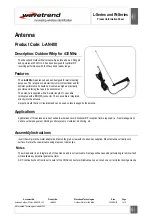
Antenna Placement for Best Signal
Assembly Instructions
Antennas rely on line of sight, so to get the best performance place the antenna where it
has a clear view. An obstruction like a building or hill immediately in front of the
antenna reduces signal more than a building down the street. Try and avoid placing the
antenna within 3 feet of any metal objects that could interfere with reception.
TV Transmitter
If you live in a valley or
have obstructions, try
and put the antenna up
higher to compensate
for signal loss.
Installing an antenna
in the attic makes it
may require you to
use a larger antenna
Being at an elevated
position can be
helpful for antenna
reception.
Aiming your Antenna
WARNING
RISK OF ELECTROCUTION
This antenna picks up
approximately 60°
wide out of 360°. Aim
the antenna to face
the center of the
group of stations you
are trying to receive.
If you are having
trouble getting a
particularly weak
channel, you can
try pointing the
antenna directly at
the compass heading.
This information
is available from
sites like
www.antennaweb.org
Every year people are injured or killed from
antennas or mast making contact with
overheard power lines. Be sure to check
mounting site to ensure there is no risk of
antenna touching a power line.
Always be aware, and use caution when
going up on a roof. Besides the risk of
falling, the electrical shock that comes from
contacting a power line with your antenna
or mast is equal to being struck by a bolt of
lightning
www.xtremesignal.com
Tel 1.877.697.4462
Please check your local electrical code for
grounding requirements. Outdoor antennas
should be grounded. Call Solid Signal today or
visit solidsignal.com for a selection of
grounding blocks and grounding accessories.
Grounding
60°
Top-down view of
antenna
by Solid Signal
FRONT
Reflector
Element
Matching
Transformer
(must face TV station)
Phasing Lines
Spacers
Attach
antennas
together with
bolts and hex
nuts installed
in larger
section.
Bolt
Hex Nut
Mast Clamp
Back
Boom
FIGURE 2
FIGURE 2
Nut
Bolt
Remove antenna from carton. Unfold elements and reflectors. Make sure that they are straight and
perpendicular to the boom.
Attach mast clamp to the back boom (larger antenna section) antenna using the screw and hex
nut supplied, Fig. 2.
Using the bolts and hex nuts provided, attach the smaller section to the larger section of the
antenna using the spacers as shown in Figure 1.
Mount antenna on top of mast and lightly tighten mast clamps.
On the back of the smaller section line up the two phasing lines and insert the smaller screws from
the hardware bag so that the head of each screw faces the larger section of the antenna. Place two
washers on each screw and install the nut to hold the washers in place DO NOT TIGHTEN. Connect
matching transformer to the downlead connection. Slide spade lugs of matching transformer
between the washers. Tighten hex nuts securely. With the screws in place, connect the coax
downlead to the matching transformer on the antenna, but do not secure at this time. Then
connect the coaxial cable to your TV.
Point front of antenna towards stations and tighten mast clamp securely, Figure 1.
Secure coaxial downlead to the mast using tape to prevent whipping by the wind.
Ground antenna and mast.
Step 1.
Step 2.
Step 3.
Step 4.
Step 5.
Step 6.
Step 7.
Step 8.




















